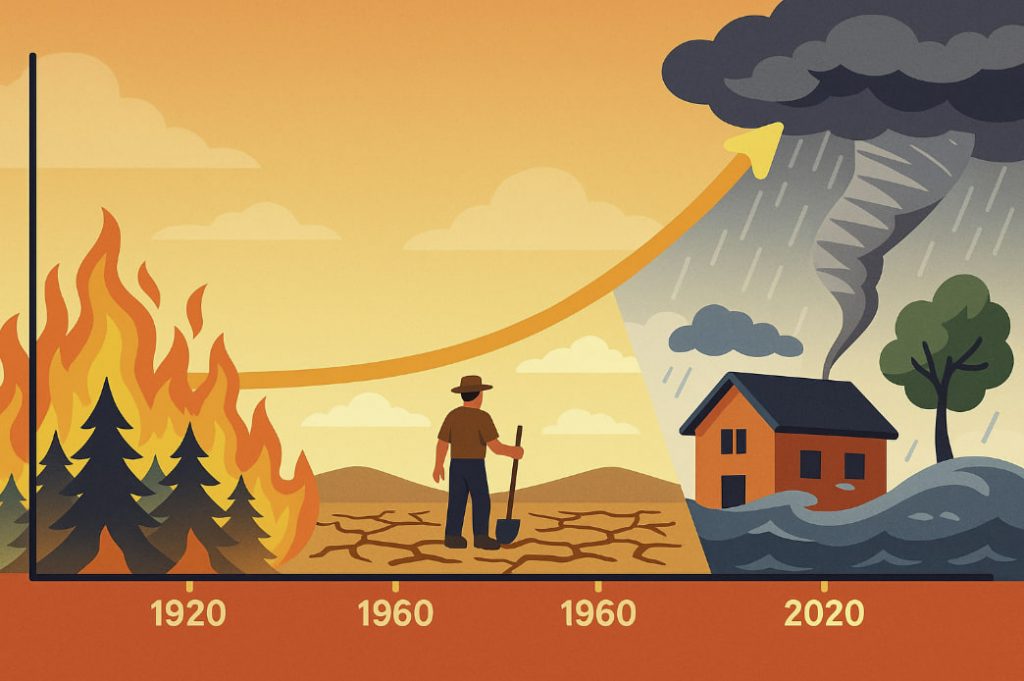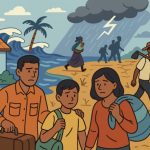Over the last century, the Earth has witnessed a dramatic increase in climate-related disasters. From devastating floods and hurricanes to severe droughts and wildfires, these events are becoming more frequent, intense, and costly. This article explores how climate disasters have evolved over the past 100 years, what’s driving this surge, and what it means for the future.
What Are Climate Disasters?
Climate disasters are extreme weather events intensified or triggered by changes in the climate system. These include:
- Heatwaves
- Hurricanes and cyclones
- Floods and heavy rainfall
- Wildfires
- Droughts
- Sea-level rise and coastal erosion
Such events often lead to massive human displacement, economic loss, ecosystem damage, and public health emergencies.
Historical Timeline: A Century of Change
1920s–1950s: Natural Variability Dominates
- Climate disasters occurred, but were typically regional and weather-driven.
- Long-term data was limited, and global coordination was minimal.
- Human influence on climate was small, but industrialization was rising.
1960s–1980s: Warnings and First Patterns
- Satellite technology began tracking storms, rainfall, and drought.
- Scientists started linking CO₂ emissions to global warming.
- Events like the 1982 El Niño and 1970 Bangladesh cyclone showed new levels of devastation.
1990s–2000s: Climate Change Accelerates
- UN established the Intergovernmental Panel on Climate Change (IPCC).
- Heatwaves in Europe (2003), hurricanes like Katrina (2005), and severe wildfires in Australia raised alarms.
- Data confirmed increasing global temperatures, rising sea levels, and stronger storm systems.
2010s–2020s: The Age of Mega-Disasters
- Unprecedented wildfires (Australia, California, Canada), record-breaking hurricanes, deadly floods (Pakistan, Germany, India), and rising migration from climate hotspots.
- Climate disasters are now happening more than four times as often as in the 1970s, according to the UN Office for Disaster Risk Reduction.
What’s Causing the Surge?
1. Rising Global Temperatures
- Warmer air holds more moisture, fueling intense storms and floods.
- Heatwaves are longer and deadlier — now occurring even in temperate zones.
2. Melting Ice and Sea-Level Rise
- Loss of glaciers and polar ice increases ocean volume and coastal flooding.
- Low-lying nations and islands are losing land every year.
3. Changing Rainfall Patterns
- Some regions face intense drought; others suffer torrential rains.
- Water cycles are disrupted, affecting farming, infrastructure, and health.
4. Deforestation and Land Degradation
- Forest loss contributes to CO₂ buildup and reduces natural flood control.
- Land clearing in fire-prone areas makes wildfires harder to contain.
Impacts Around the World
| Region | Notable Climate Disasters |
|---|---|
| North America | Hurricanes (Katrina, Harvey, Ian), wildfires |
| Europe | Heatwaves (2003, 2022), flash floods (Germany) |
| South Asia | Monsoon floods (Pakistan, India), droughts |
| Africa | Droughts in Horn of Africa, locust swarms |
| Australia | Bushfires (Black Summer 2019–2020) |
| Latin America | Amazon droughts, hurricanes, landslides |
| Pacific Islands | Sea-level rise and cyclones |
Economic and Human Toll
- Deaths from climate disasters number in the millions over the last century
- Damage costs have skyrocketed — from billions to trillions of dollars
- Disasters now displace an average of 20–30 million people each year
- Poor and vulnerable communities suffer disproportionately
Can We Change the Trend?
Yes — through mitigation and adaptation:
- Cut greenhouse gas emissions to limit further warming
- Invest in resilient infrastructure and disaster warning systems
- Support climate-smart agriculture and urban planning
- Protect and restore natural buffers (forests, wetlands, coral reefs)
- International cooperation to finance adaptation and protect at-risk regions
Conclusion
The rise in climate disasters over the past 100 years is not random — it reflects a planet under growing environmental stress. Scientific models warned us, and now the data confirms it: we are living through a new era of climate extremes. While the risks are real and rising, so too are the opportunities for global action, innovation, and resilience.
Glossary
- Climate disaster – an extreme weather event intensified or triggered by climate change
- Greenhouse gas – gases like CO₂ and methane that trap heat in Earth’s atmosphere
- Resilience – the ability of a system or community to recover from shocks
- Adaptation – actions taken to adjust to actual or expected climate effects
- IPCC – Intergovernmental Panel on Climate Change, the UN’s climate science body


